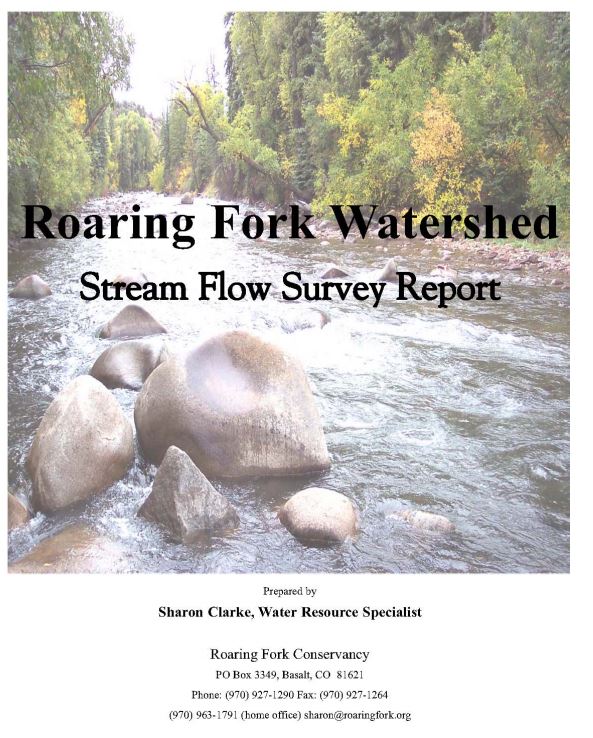EXECUTIVE SUMMARY
Similar to most western watersheds, the Roaring Fork Watershed’s flows have been, and continue to be, altered to meet agricultural, municipal, and industrial demands within and beyond the watershed boundaries. Aspects of the flow regime, including flow magnitude, timing and duration of high and low flows, and rate of change, are related to important biological and geomorphological processes that influence overall stream health. With the recent recognition of the importance of stream health to the economic and environmental sustainability of the watershed, government officials and stakeholders are more willing to identify and pursue flow regimes that meet biological needs while still providing beneficial consumptive uses. This dialog brings forth some important questions such as “how much water is needed, at what times, and for what duration?”.
These questions frame the Roaring Fork Watershed Stream Flow Survey Project (the Project). This report covers the project data collection and analyses preformed to date. Optimum conditions for one species or process may not be optimum for another; therefore, identifying desired flows should not focus on the needs of a single aspect. Stream ecosystems have evolved to adapt to a range of conditions, known as the range of natural variability. The range of natural variability for each flow parameter can be determined using daily mean stream flow data, where a sufficient period of unaltered flow data is available. The Project has involved gathering and synthesizing relevant data and assessing the applicability of appropriate tools to identify broad ecologically sustainable flow thresholds and critical areas to protect or restore. Hydrologic alteration was assessed for the Roaring Fork Watershed using daily mean stream flow gage data from three sources, as well as modeled stream flow data and several analytical methods. The modeled data representing pre-developed and developed monthly flows for the period of record (1908-1996) for 33 locations throughout the watershed provided better temporal and spatial representation of flows than the available gage data. A third assessment was made using real time daily mean stream flow data to determine how often and when Colorado Water Conservation Board instream flows were met.
The results of these analyses are discussed for the nine sub-watersheds in the Roaring Fork Watershed. We found that much of the significant hydrologic alteration is seasonal, contributed by activities such as irrigated agriculture or snowmaking. Although, the alterations can be severe (occur over all months in a season), there is a significant return flow from these activities. Other water uses cause hydrologic alteration throughout the year including trans-mountain diversions, Ruedi Reservoir management, and diversion for domestic water supplies. For example, Nettle Creek, a small tributary of the Crystal River that supplies water to Carbondale, experiences year-round hydrologic alteration. The trans-mountain diversions are one hundred percent consumptive. In the case of the Upper Roaring Fork River Sub-Watershed the effects occur in all seasons and result in unfulfilled CWCB instream flow rights. Although the Boustead Tunnel in the Fryingpan River Sub-Watershed diverts more water than the Twin Lakes Tunnel, severe effects in this sub-watershed are not seen year-round. Overall hydrologic alteration below Ruedi Reservoir is rated as severe. However, unlike many other alterations that result in lower, developed flows are significantly higher than pre-developed flows in all seasons for at least a period of one month.
These results, along with conservation targets identified by The Nature Conservancy’s Conservation Action Planning Process, will be used to prioritize areas for more in-depth hydrologic analyses. Additionally, these results will be instrumental in identifying water quantity issues for the newly initiated watershed planning process. Integration with the design of the watershed plan enhances our ability to reach the overall Project goal, which is to respond to instream flow issues and pursue approaches for achieving sustainable stream flows. Plans to improve flows in two highly altered areas, and an overview of several potential flow protection or restoration options to achieve sustainable stream flows, are presented as they relate to the overall project goal.
